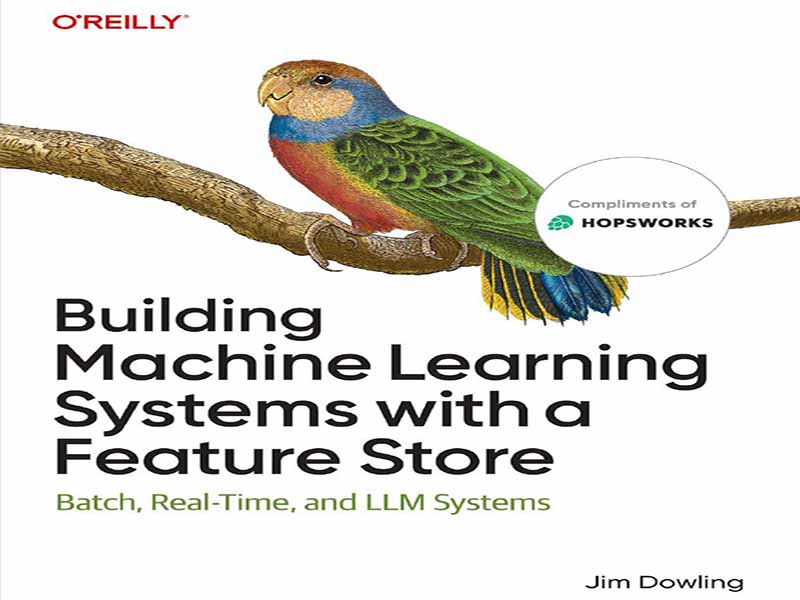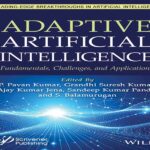- عنوان کتاب: Building Machine Learning Systems with a Feature Store Batch, Real-Time, and LLM Systems
- نویسنده: Jim Dowling
- حوزه: یادگیری ماشین
- سال انتشار: 2026
- تعداد صفحه: 693
- زبان اصلی: انگلیسی
- نوع فایل: pdf
- حجم فایل: 12.6 مگابایت
هوش مصنوعی یک حوزه گسترده و عمیق است. اگر تا به حال مدلی را آموزش ندادهاید، ممکن است احساس کنید که برای شروع به مدرک دکترا نیاز دارید. اگر مدلی را آموزش دادهاید، ساخت یک سیستم یادگیری ماشین (ML) میتواند این حس را به شما بدهد که ابتدا باید هم مهندس داده و هم متخصص Kubernetes یا فضای ابری شوید. ممکن است از قبل در زمینه یادگیری ماشین یا هوش مصنوعی تجربه داشته باشید. شاید مدلی را روی یک مجموعه داده استاتیک آموزش داده باشید. یا ممکن است از طریق ایجاد یک دستور، در مورد مدلهای زبان بزرگ (LLM) آموخته باشید به طوری که یک کار را با موفقیت انجام داده باشید. اما برای ایجاد ارزش واقعی از هوش مصنوعی، باید از مجموعه دادههای استاتیک و دستورات استاتیک به دادههای پویا و مهندسی زمینه حرکت کنید. وقتی یک مدل را آموزش میدهید، به سیستمی نیاز دارید که پیشبینیهای زیادی را با آن انجام دهد، نه فقط پیشبینیها روی مجموعه داده استاتیکی که دانلود کردهاید. وقتی یک برنامه را با هوش مصنوعی فعال میکنید، لازم نیست پاسخهای یکسانی را برای همه کاربران تنظیم کنید. میتوانید با ارائه اطلاعات زمینهای تازه و مرتبط در زمان درخواست، هوش مصنوعی را شخصیسازی کنید. سیستمهای یادگیری ماشین و هوش مصنوعی بیشترین ارزش را زمانی ایجاد میکنند که با دادههای پویا کار میکنند. خطوط لوله کلید این امر هستند. شما به خطوط لوله نیاز دارید تا دادههای پویا را از منابع داده خود به فرمتی تبدیل کنید که بتواند برای هر چیزی از آموزش مدل شما گرفته تا انجام پیشبینیها و ارائه اطلاعات زمینهای برای LLM شما استفاده شود. در این کتاب، سیستمهای یادگیری ماشین را به عنوان توالی خطوط لوله تعریف خواهیم کرد. آنها دادهها را به تدریج از منابع داده تبدیل میکنند تا زمانی که به عنوان ورودی به یک مدل برای آموزش یا استنتاج (انجام پیشبینیها) استفاده شوند. خطوط لوله ما را قادر میسازند تا هنگام توصیف یک سیستم یادگیری ماشین یا هوش مصنوعی، سطح انتزاع را بالا ببریم. آیا یک مدل از دادههای ویژگی شما؟ آیا پیشبینیها را با استفاده از مدلی که آموزش دادهاید، خروجی میدهد؟ خطوط لوله به ما کمک میکنند تا سیستم یادگیری ماشین یا هوش مصنوعی خود را به اجزای مدولار تجزیه کنیم. خواهیم دید که چگونه فروشگاه ویژگی، یک پلتفرم مدیریت داده برای هوش مصنوعی، ترکیب خطوط لوله را به سیستمهای یادگیری ماشین یا هوش مصنوعی کارآمد امکانپذیر میکند. همچنین خواهید دید که سفر به سمت ساخت خطوط لوله برای سیستمهای هوش مصنوعی مشابه سفر به سمت ساخت خطوط لوله برای سیستمهای یادگیری ماشین است. مهندسی زمینه برای عاملها از بسیاری از اصول مشابه مهندسی ویژگی برای مدلهای یادگیری ماشین کلاسیک پیروی میکند. این کتاب مفید است زیرا میتواند به شما در ساخت انواع مختلف سیستمهای یادگیری ماشین و هوش مصنوعی از ابتدا کمک کند. یک سیستم یادگیری ماشین در دنیای واقعی به ندرت یک مجموعه داده آماده را پردازش میکند و یک معیار واضح را بهینه میکند. در عوض، اغلب یک فرآیند آشفته شناسایی «مسئله پیشبینی» مناسب برای حل منابع داده موجود؛ مدیریت با جریانهای داده افزایشی و بیپایان؛ گاهی آموزش یا تنظیم دقیق یک مدل؛ و ساخت یک رابط کاربری را پیادهسازی میکند تا ذینفعان بتوانند از مدل شما ارزش کسب کنند. سیستم یادگیری ماشین شما همچنین باید به خوبی مهندسی شده باشد، نه یک خانه پوشالی. قبل از ورود به تولید باید آزمایش شود و پس از تولید، نظارت شود. و شما باید بهترین شیوهها را در آزمایش خودکار و استقرار برای مهندسی نرمافزار دنبال کنید. این کتاب میتواند به شما در دستیابی به مهارتهای یک دانشمند داده یا مهندس ارشد یادگیری ماشین کمک کند.
AI is a wide and deep field. If you’ve never trained a model, it can feel like you need a PhD just to begin. If you have trained a model, building a machine learning (ML) system can feel like you need to first become both a data engineer and a Kubernetes or cloud expert. You may already have some experience in ML or AI. Maybe you trained a model on a static dataset. Or you may have learned about large language models (LLMs) through crafting a prompt such that you successfully accomplished a task. But to create real value from AI, you need to move from static datasets and static prompts to dynamic data and context engineering. When you train a model, you need a system that will make many predictions with it, not just predictions on the static dataset you downloaded. When you AI-enable an application, you don’t have to hardwire the same responses for all users. You can personalize the AI by providing fresh and relevant context information at request time. ML and AI systems create the most value when they work with dynamic data. Pipelines are key to this. You need pipelines to transform the dynamic data from your data sources into a format that can be used for anything from training your model, to making predictions, to providing context information for your LLM. In this book, we will define ML systems as sequences of pipelines. They transform data progressively from data sources until it is used as input to a model for training or inference (making predictions). Pipelines enable us to lift the level of abstraction when describing an ML or AI system. What is the pipeline’s input and output? Does it create feature data from your data sources? Does it train a model from your feature data? Does it output predictions using the model you trained? Pipelines help us decompose our ML or AI system into modular components. We will see how the feature store, a data management platform for AI, enables the composition of pipelines into working ML or AI systems. You will also see that the journey to building pipelines for AI systems is similar to the journey to building pipelines for ML systems. Context engineering for agents follows many of the same principles as feature engineering for classical ML models. This book is useful because it can help you build different types of ML and AI systems from scratch. A real-world ML system rarely processes a readymade dataset and optimizes a clear metric. Instead, it often implements a messy process of identifying the right “prediction problem” to solve for available data sources; managing with incremental, never-ending data flows; sometimes training or fine-tuning a model; and building a user interface so that stakeholders can get value from your model. Your ML system should also be well engineered, not a house of cards. It needs to be tested before it goes into production and monitored once in production. And you should follow best practices in automated testing and deployment for software engineering. This book can help you attain the skills of a staff data scientist or lead ML engineer.
این کتاب را میتوانید از لینک زیر بصورت رایگان دانلود کنید:
Download: Building Machine Learning Systems with a Feature Store Batch, Real-Time, and LLM Systems



































نظرات کاربران